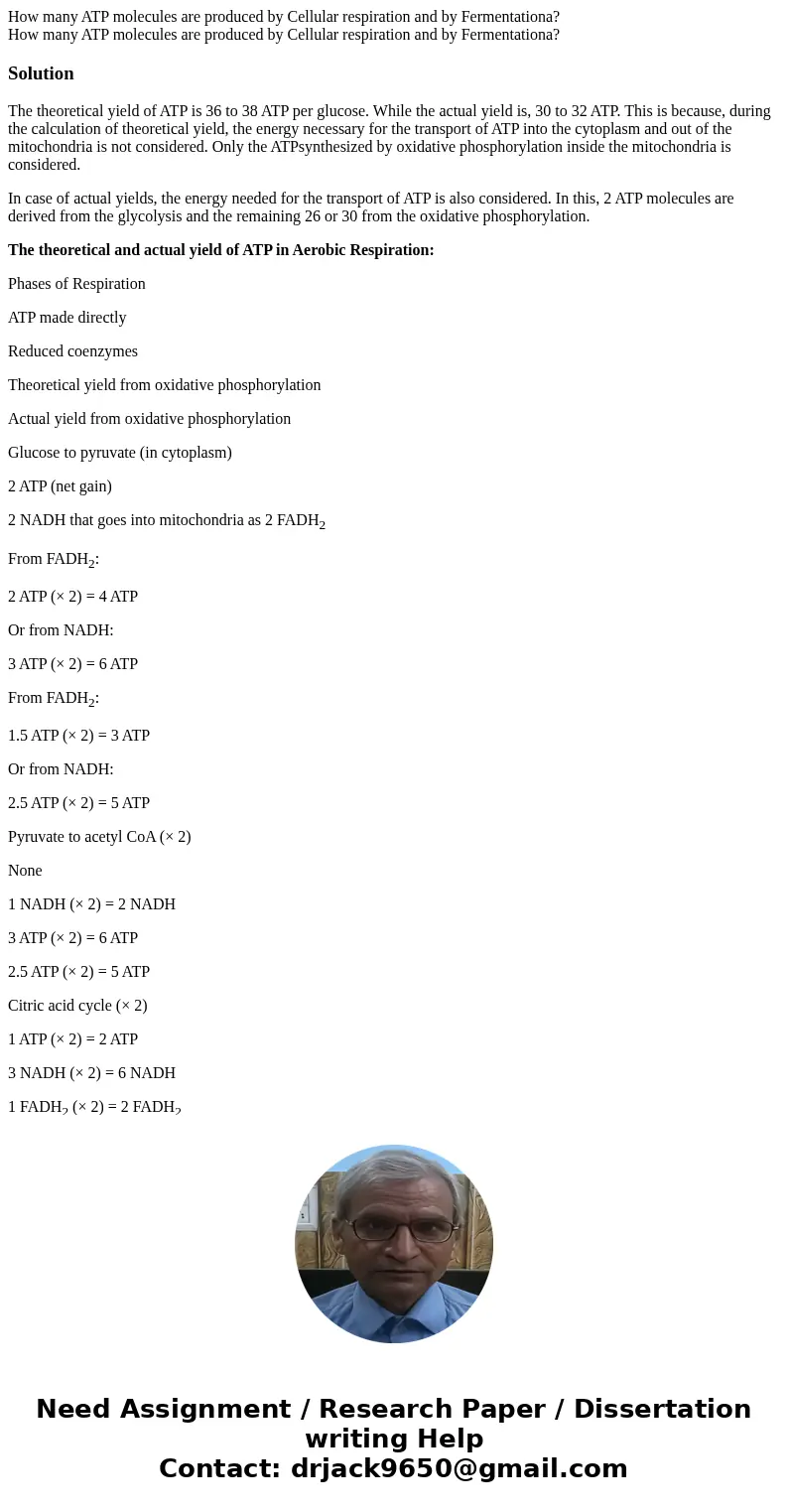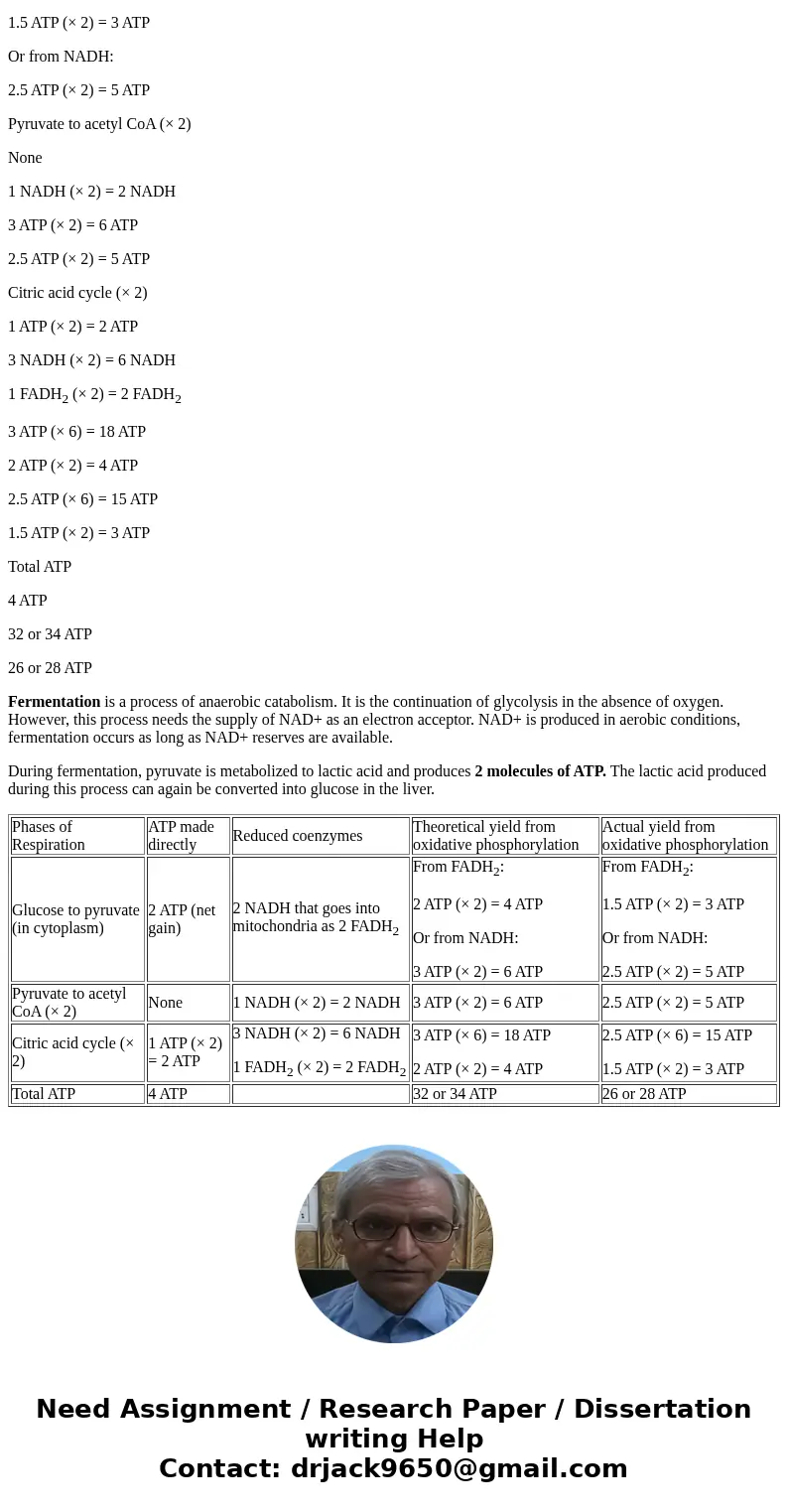How many ATP molecules are produced by Cellular respiration
Solution
The theoretical yield of ATP is 36 to 38 ATP per glucose. While the actual yield is, 30 to 32 ATP. This is because, during the calculation of theoretical yield, the energy necessary for the transport of ATP into the cytoplasm and out of the mitochondria is not considered. Only the ATPsynthesized by oxidative phosphorylation inside the mitochondria is considered.
In case of actual yields, the energy needed for the transport of ATP is also considered. In this, 2 ATP molecules are derived from the glycolysis and the remaining 26 or 30 from the oxidative phosphorylation.
The theoretical and actual yield of ATP in Aerobic Respiration:
Phases of Respiration
ATP made directly
Reduced coenzymes
Theoretical yield from oxidative phosphorylation
Actual yield from oxidative phosphorylation
Glucose to pyruvate (in cytoplasm)
2 ATP (net gain)
2 NADH that goes into mitochondria as 2 FADH2
From FADH2:
2 ATP (× 2) = 4 ATP
Or from NADH:
3 ATP (× 2) = 6 ATP
From FADH2:
1.5 ATP (× 2) = 3 ATP
Or from NADH:
2.5 ATP (× 2) = 5 ATP
Pyruvate to acetyl CoA (× 2)
None
1 NADH (× 2) = 2 NADH
3 ATP (× 2) = 6 ATP
2.5 ATP (× 2) = 5 ATP
Citric acid cycle (× 2)
1 ATP (× 2) = 2 ATP
3 NADH (× 2) = 6 NADH
1 FADH2 (× 2) = 2 FADH2
3 ATP (× 6) = 18 ATP
2 ATP (× 2) = 4 ATP
2.5 ATP (× 6) = 15 ATP
1.5 ATP (× 2) = 3 ATP
Total ATP
4 ATP
32 or 34 ATP
26 or 28 ATP
Fermentation is a process of anaerobic catabolism. It is the continuation of glycolysis in the absence of oxygen. However, this process needs the supply of NAD+ as an electron acceptor. NAD+ is produced in aerobic conditions, fermentation occurs as long as NAD+ reserves are available.
During fermentation, pyruvate is metabolized to lactic acid and produces 2 molecules of ATP. The lactic acid produced during this process can again be converted into glucose in the liver.
| Phases of Respiration | ATP made directly | Reduced coenzymes | Theoretical yield from oxidative phosphorylation | Actual yield from oxidative phosphorylation |
| Glucose to pyruvate (in cytoplasm) | 2 ATP (net gain) | 2 NADH that goes into mitochondria as 2 FADH2 | From FADH2: 2 ATP (× 2) = 4 ATP Or from NADH: 3 ATP (× 2) = 6 ATP | From FADH2: 1.5 ATP (× 2) = 3 ATP Or from NADH: 2.5 ATP (× 2) = 5 ATP |
| Pyruvate to acetyl CoA (× 2) | None | 1 NADH (× 2) = 2 NADH | 3 ATP (× 2) = 6 ATP | 2.5 ATP (× 2) = 5 ATP |
| Citric acid cycle (× 2) | 1 ATP (× 2) = 2 ATP | 3 NADH (× 2) = 6 NADH 1 FADH2 (× 2) = 2 FADH2 | 3 ATP (× 6) = 18 ATP 2 ATP (× 2) = 4 ATP | 2.5 ATP (× 6) = 15 ATP 1.5 ATP (× 2) = 3 ATP |
| Total ATP | 4 ATP | 32 or 34 ATP | 26 or 28 ATP |


 Homework Sourse
Homework Sourse